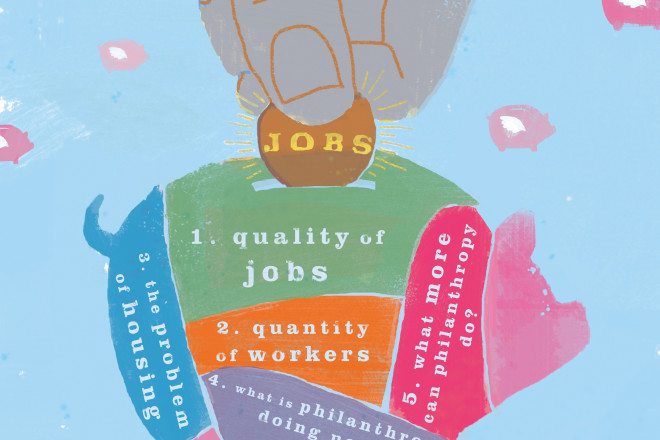Philanthropy Supporting Business
- Share
- Tweet
- Pin
- Share

There’s a fascinating shift going on in modern philanthropy. Many of our nation’s most ingenious philanthropic institutions are broadening their focus. Rather than limiting themselves to awarding grants to nonprofit organizations, foundations are increasingly recognizing that the entrepreneurial spirit is an invaluable tool to achieve their goals for the community. As a result, these charitable philanthropies are making investments that use the for-profit motive in innovative ways.
Examples are popping up every day across the country. The Cleveland (community) Foundation has been at the forefront of creating “evergreen cooperatives.” Rather than offer a subsidy to induce a corporation to bring jobs into a community, this new model creates employment opportunities by investing in new local, employee-owned businesses. The Oregon Community Foundation has made “economic vitality” one of its strategic priorities. It’s making investments in developing workforce skills and providing entrepreneurial education.
The line between philanthropy and business is blurring even on our little peninsula. At the Door County Community Foundation, we’ve launched the Community Opportunity Investment Network (COIN). COIN fosters the creation of new jobs by making small business loans available to entrepreneurs that do not have access to traditional lending. In the last year in Door County, three new businesses were launched and one was able to expand as a direct result of COIN loans.
While much attention is being focused on how the world of philanthropy is intersecting with the for-profit sector, I was asked to comment as to why this is occurring. What’s driving our philanthropic institutions to use investments in for-profit businesses to realize their charitable goals?
The most obvious explanation is that an enormous number of social issues directly correlate to a family’s income. Life expectancy, obesity, crime, alcohol and drug abuse, domestic violence, and numerous other problems all have a strong and demonstrated link to poverty. Of course, there are plenty of fat, rich alcoholics who beat their spouses, so these problems are most certainly not limited to the poor. Yet we would be ignoring reality if we didn’t heed the countless studies which demonstrate an overwhelming correlation — and very often a causal link — between poverty and these societal problems.
Thus, foundations have simply concluded that the most obvious solution to address a myriad of issues is to help lift families out of poverty.
Our challenge is that the problem of poverty, particularly among children, is getting worse. The Annie E. Casey Foundation’s 2015 Kids Count Data Book reports that nearly 1 out of every 4 children in the United States lives in poverty. That number has grown by more than 20 percent during the last five years. Poverty among our nation’s children is reaching epidemic proportions.
Yet a statistic from the Philanthropy Roundtable’s Clearing Obstacles to Work by David Bass gets to the heart of why foundations are making investments in economic development. If every poor family in the U.S. had at least one person with a full-time job, 75 percent of today’s poor children would be lifted out of poverty.
Fostering the development of businesses that have the potential to grow and create new jobs is the most effective and lasting poverty eradication program there is.
However, there’s more to a job than just material gain. There are emotional and social benefits as well. “When they are separated from work, the poor lose more than just money for food, shelter and clothing,” writes Bass. “They suffer deficits of purpose, emotional well-being, and social connection. They get cut off from clearly defined goals and aspirations. They lose a prime means of generating and feeling respect from others. These things can’t be compensated for by government income transfers or charitable gifts. This itch must be scratched by devoting oneself to productive, fulfilling labor.”
If you talk with someone who recently got a job you know just how true that is. Certainly the newly employed want and expect to get paid, but it’s almost never the first thing that they say to you.
“When they find that new job, they just transform,” says Sandy Duckett, CEO of We Are HOPE, Inc. which houses the Door County Job Center. “You can see their self-confidence, their self-worth grow. They are reminded they have value.”
Like most Americans, I still have a strong belief in the value of hard work. Yet it is a mistake to conclude that foundations have wholeheartedly embraced the old adage that if you give a man a fish, he’ll eat for a day, but if you teach a man to fish, he’ll eat for a lifetime. While that sounds like sage wisdom, if you’ve ever worked with those living in poverty you know it’s not that simple.
Parents who are trying to figure out how they’re going to feed their children dinner tonight aren’t thinking of ways to improve their job skills. A man who is homeless doesn’t have an address to list on his résumé. The woman who is chronically ill has a hard time getting herself to a class at the technical college. A child who is the victim of abuse cannot concentrate on school work. If you try to teach a hungry man to fish, he’s going to eat the bait.
Thus we need to do both things. Foundations should invest in efforts which lift people out of poverty through workforce education and fostering the entrepreneurial spirit, but we also must support those charities that provide for our community’s basic human needs. Let’s give the hungry man a meal, then we’ll teach him how to fish.

